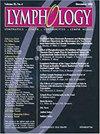Skin lymphatic system in the pathogenesis of arterial hypertension - review and critique.
IF 0.7
4区 医学
Q4 IMMUNOLOGY
引用次数: 3
Abstract
Although numerous studies have confirmed the relationship between high salt intake and elevated blood pressure, the exact molecular mechanisms of this relationship are still unclear. There is growing evidence that skin interstitium, as well as the skin lymphatic system, are important regulators of both sodium (Na+) balance and blood pressure. Skin is in itself a large reservoir of Na+ ions which are stored in an osmotically inactive form on glycosaminoglycans (GAGs). Local hypertonicity due to extensive accumulation of Na+ within the skin as a result of a high-salt diet was demonstrated to induce macrophages to express a transcription factor termed tonicityresponsive enhancer binding protein (TonEBP) and subsequently to secrete vascular endothelial growth factor-C (VEGF-C), activating lymphangiogenesis within the skin. This regulatory axis seems to be adaptive in maintaining blood pressure in high salt-load states. Recent studies have added new insights into the functioning of lymphatic vessels and the pathogenesis of salt-sensitive hypertension as well as questioned the classic view of Na+ homeostasis. This review aims to summarize recent findings pertaining to the involvement of the skin lymphatic system in Na+ and blood pressure regulation.皮肤淋巴系统在动脉高血压发病机制中的研究综述与批判。
尽管大量的研究已经证实了高盐摄入和血压升高之间的关系,但这种关系的确切分子机制仍不清楚。越来越多的证据表明,皮肤间质以及皮肤淋巴系统是钠(Na+)平衡和血压的重要调节因子。皮肤本身就是一个巨大的Na+离子储存库,这些Na+离子以渗透性不活跃的形式储存在糖胺聚糖(GAGs)上。高盐饮食导致的皮肤内Na+的大量积累导致局部高渗性,可诱导巨噬细胞表达一种称为张力响应增强子结合蛋白(TonEBP)的转录因子,随后分泌血管内皮生长因子- c (VEGF-C),激活皮肤内的淋巴管生成。这种调节轴似乎在维持高盐负荷状态下的血压方面具有适应性。近年来的研究为淋巴管的功能和盐敏感性高血压的发病机制提供了新的见解,并对Na+稳态的经典观点提出了质疑。本文综述了近年来有关皮肤淋巴系统参与Na+和血压调节的研究结果。
本文章由计算机程序翻译,如有差异,请以英文原文为准。
求助全文
约1分钟内获得全文
求助全文
来源期刊

Lymphology
医学-免疫学
CiteScore
5.20
自引率
8.00%
发文量
29
审稿时长
3 months
期刊介绍:
The Journal contains original articles, special features (see below), and information regarding the International Society of Lymphology. It seeks original papers dealing with clinical and basic studies of the lymphatic system and its disorders including related fields. Articles are accepted for external review and publication on the condition that they are contributed to Lymphology only and that no substantial part has been or will be published elsewhere.
 求助内容:
求助内容: 应助结果提醒方式:
应助结果提醒方式:


